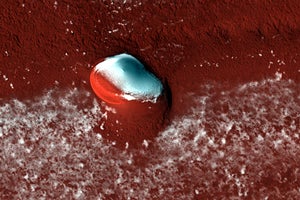Alfred McEwen, a University of Arizona planetary scientist at the Lunar and Planetary Laboratory (LPL), studied the solitary hill in a new detailed image from the HiRISE (High Resolution Imaging Science Experiment) camera onboard NASA’s Mars Reconnaissance Orbiter.
The north polar-layered deposits stack up to several miles high and represent one of the largest surface reservoirs of martian water that interacts with the planet’s atmosphere, LPL’s Shane Byrne said. Scientists believe the deposits record orbitally driven climate changes, so they study the features to learn how Mars’ climate evolved.
The new HiRISE image shows an exposed 1,640 foot-thick (500-meter) section of this layering, and also a 130-foot high (40-meter) conical mound sticking out of the slope. “The mound may be the remnant of a buried impact crater, which is now being exhumed,” Byrne said.
As the layered deposits accumulated ice would have buried the impact craters, with layers wrapping around the crater, Byrne said. Almost none exists on the surface of this terrain.
“But in this rare case, erosion formed a trough that uncovered one of these structures. For reasons that are poorly understood right now, the ice beneath the site of the crater is more resistant to this erosion, so that as this trough formed, ice beneath the old impact site remained, forming this isolated hill,” Byrne said.
The HiRISE image at full resolution shows polygonal blocks as big as 33 feet (10 meters) across make up the mound, Byrne added. Reddish dust covers the blocks, but otherwise they resemble ice-rich blocks seen in other images of the north polar-layered deposits.
The seven new HiRISE images released October 16 include another image of an impact crater where such features are rarely seen on the north polar cap. HiRISE turned up a small crater, only about 375 feet (115 meters) in diameter on the surface of Planum Boreum, popularly known as the north polar cap.
The dearth of craters has led scientists to suggest that either the north polar cap is only about 100,000 years old or that crater impacts into the ice disappear as the ice relaxes, just as imperfections disappear as old window glass relaxes.
Color in the enhanced-color version of the Planum Boreum impact crater comes from dust and ice of various grain sizes. Blue ice has a larger grain size than the ice that has collected in the crater. Dust is red. A smooth area stretching away from the crater to the upper right of the image may be caused by winds around the crater or by fine-grained ice and frost blowing out of the crater, HiRISE scientists say.










